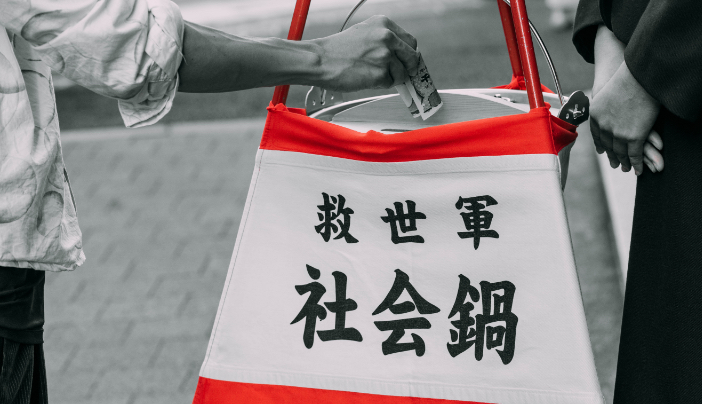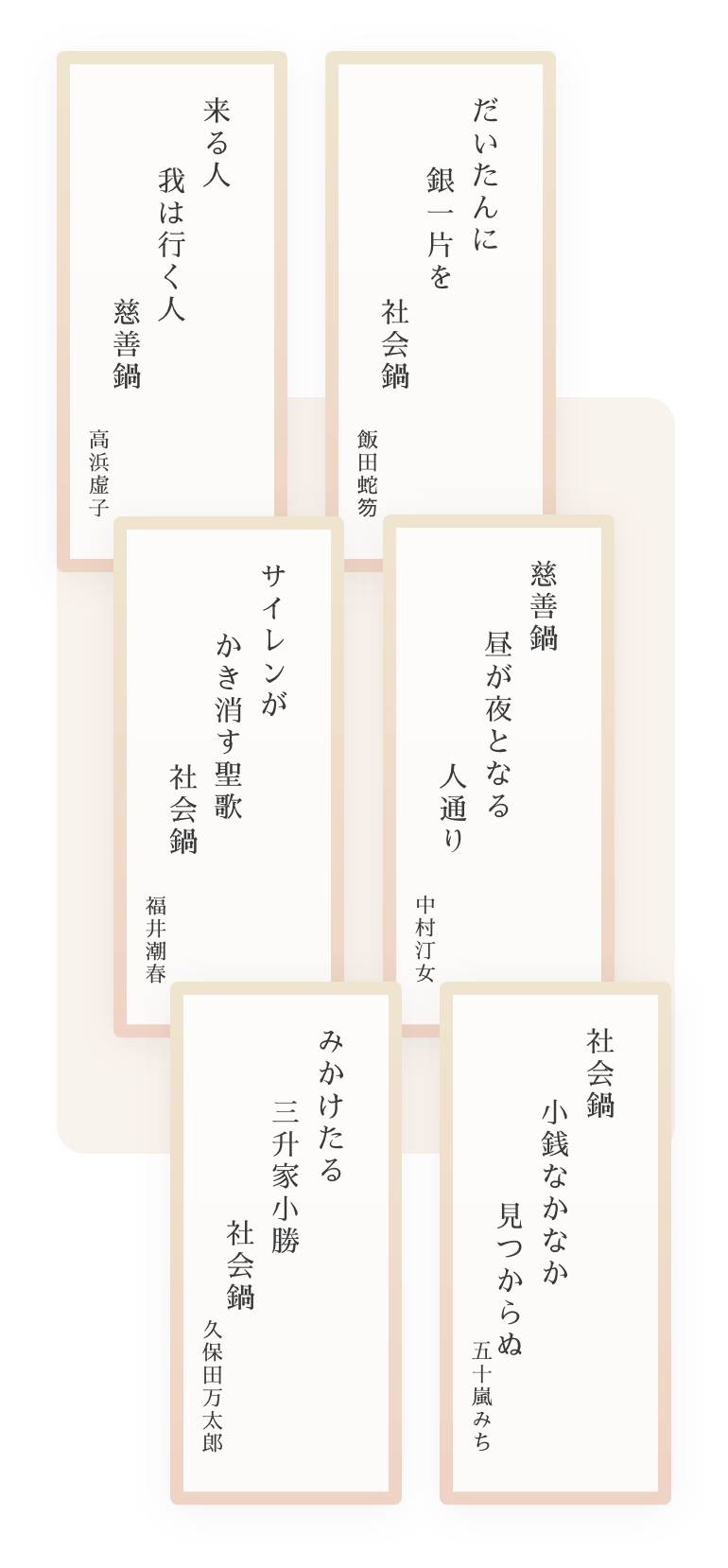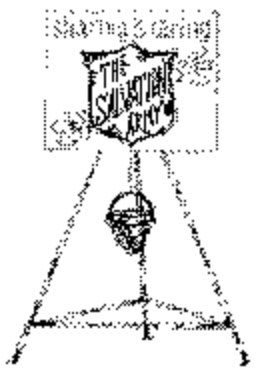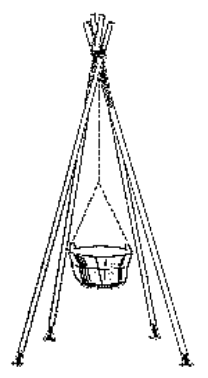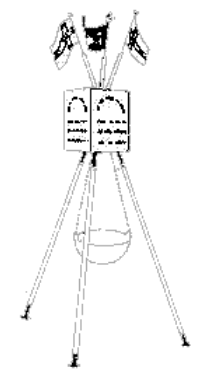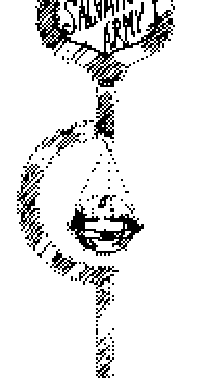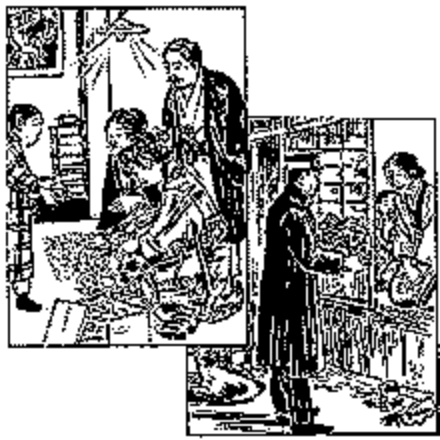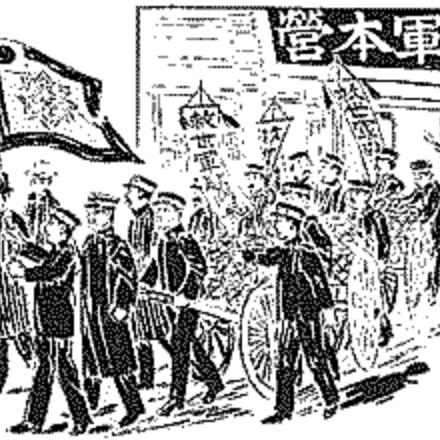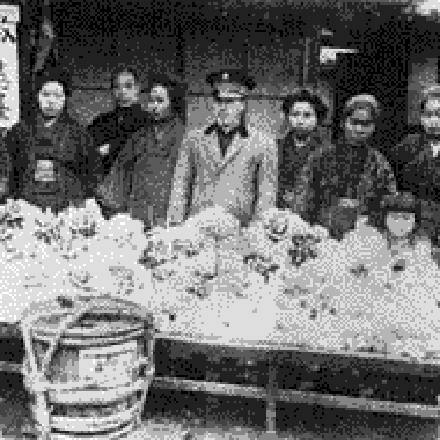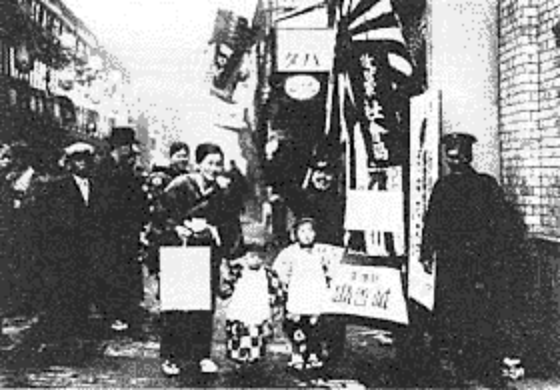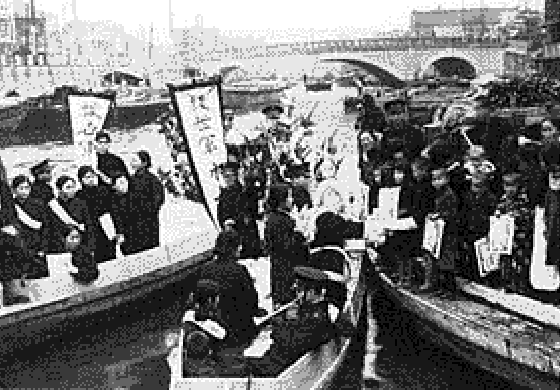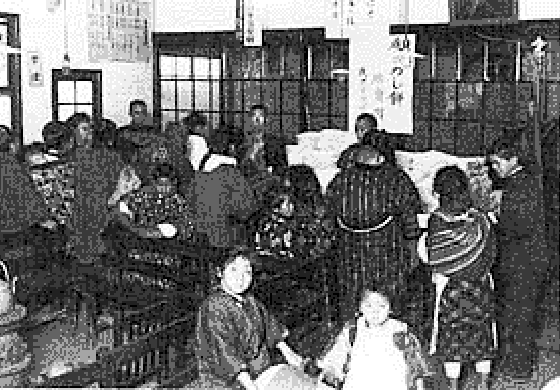2024年の予定
- イベント
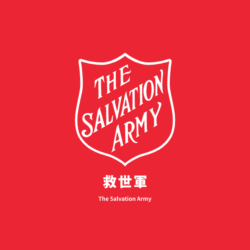
“The King will reply, ‘Truly I tell you, whatever you did for one of the least of these brothers and sisters of mine, you did for me.’”
(Matthew 25:40)
My name is Shakainabe, nice to meet you. As everyone already know, my name is Shakainabe. Every year around Christmas, my friends stand on the streets with the Salvation Army soldiers from all over the country and are loved by the people who go by. However, I do not think you know much about my background, so let me talk about it. It is nice to know that it is known as an event that announces the arrival of December, which is also written in the seasonal words of haiku.
My name is Shakainabe. My ancestor was called “Christmas Kettle” and, our first ancestor was not born in Japan. About 100 years ago from now, it was born in San Francisco, USA, during the recession of 1894. Looking back at that time, trade was sluggish, hundreds of crew members became unemployed, and their families lived a very difficult life.
Around that time, Captain Joseph McFee, who was an Officer at the Salvation Army Corps and used to be a sailor on a commercial ship, started feeding underprivileged sailor’s family with soup, receiving the order from Commissioner William McIntyre. So McFee went to the coastline area, where upper-class people lived to ask for donations and was somewhat successful but did not reach the intended budget.
One morning when Christmas was approaching, a black jar for sailor camp hung on a tripod was displayed in the shop window of the store. Seeing this, McFee bought two sets of them, set them up at the entrance to downtown Oakland and Alameda and hung a sign saying, "Please cooperate with the Salvation Army's soup reception.” He stood by the jar and shouted “please sympathize with the underprivileged sailors” to the pedestrians passing by. Immediately sympathy gathered, and we were tossed a coin into the black jar.
Just like that, the world’s first “Salvation Army soup reception” was started, and the unemployed sailors' families received unexpected reception and were able to have a happy Christmas. Then, to say the least, this first black kettle was called “Christmas Kettle”, and on December 24, 1895, the following year, thanks to the efforts of William McIntyre and N.J. Lewis, on Christmas Eve. In the eastern part of the United States, the second Christmas Kettle was issued in large numbers, and the tag “Keep the Pot Boiling” was put up beside it.
Three years later, a commentary on the “Christmas Kettle” appeared in the newspaper of New York World, stating, "This is a state-of-the-art and lofty fundraising method." This method should not be imitated by any other organization, as it is a unique idea of the Salvation Army to hang a mediocre jar on a tripod with a red stick to serve as a donation box for ease.
In 1900, this fundraising method was introduced to countries around the world, and 500,000 households benefited from it every Christmas season. This method of donation was passed on to Japan, and I became active.
It was a year 1906 (Meiji 39), where many people were unemployed in Japan, because it was immediately after the Russo-Japanese War. Right before December, Colonel Bullard, the Territorial Commander of the Salvation Army in Japan, published a "Colonel's Letter" on the Salvation Army's bulletin "The War Cry" under the title of "Consolation Basket" Plan.
It said,
“There are many people who are disadvantaged around us, and for them, New Year holidays are the most difficult times to live. In addition to the cold weather, work is absent, and the difficulties of people living that day are not trivial. For the poor, who have no money, food, and fun, can you buy some food or children's toys, put them in a basket and send them to the Salvation Army headquarters? Then we will distribute it to those who are in need. However, please note the following three points.
- Please take your own "Consolation Basket" and deliver it to the Salvation Army headquarters in Ginza 2-chome.
- If you send any items to the territorial headquarters, the Salvation Army will use them to make a "Consolation Basket", so please provide the materials.
- If you send us money, we will make a "Consolation Basket” at the territorial headquarters.
This plan was successful, and New Year's rice cakes, oranges, tabi (slippers), towels, books, etc. were delivered to families in area such as Mannencho in Shimotani, Shinnet in Shiba, and Same in Yotsuya, which were said to be the three major slums at that time. The goods were distributed in a mandarin orange basket. Also, this movement was expanded in Tokyo, Yokohama, Kobe, Sendai, Maebashi, Takasaki, and Yokosuka.
At that time, Mr. Saburo Shimada, the owner of "Tokyo Mainichi Shimbun" who was a good sympathizer of the Salvation Army, took a part of the paper and called for donations. Also, on this occasion, Gunpei Yamamuro used the money he earned from his contributions for this work. However, after the "Tokyo Mainichi Shimbun" was separated from Mr. Shimada's hands, other appropriate fund-raising methods became necessary.
That’s where I come in.
In 1909 (Meiji 42), Commissioner Gunpei Yamamuro, when he was a major at that time, decided to collect money on the street as a "relief measure for the unemployed". The method of donation was based on the idea of “Christmas Kettle” in the United States, and instead of a soup jar, he decided to hang an iron pot with the intention of ozoni (New Year soup dish) for New Year's Eve. Pots were hung in the main corners of Tokyo for collecting money, and officers and soldiers stood beside them to ask for donations.
This was appealed as “charity that can be done on the way”, and it was the first time in Japan to call me "collection pot" because it collects money in a pot. This became the origin of street fundraising during the end of the year season. However, somebody came to call it "comfort basket pot," "tripod pot," and "tripod charity pot," and in the Taisho era, it came to be called "charity tripod pot," and then "charity pot."
Even though they are called differently, the foundation was to collect charitable money for giving "Consolation Basket" containing rice cakes, oranges, and sweets to those who are in need.
In this way, I became familiar with many ordinary people.
In December 1921 (Taisho 10), the name was changed to “Shakainabe” (Social Pot). That is because the name “Charity Pot” is not the name given by the Salvation Army, but it was naturally called that way. However, the situation of the society has changed since then, and the general idea towards charity has also changed.
The position of the Salvation Army headquarters was clarified in the December 15, 1918 issue of "The War Cry". And the use of the money collected in the Shakainabe expanded from the distribution of consolation baskets to free accommodation in winter, school lunch distribution in winter, and other consolation activities. In addition to the end of the year season, we set up Shakainabe and raised money on the street when necessary, such as in disasters and relief.
One of the unique consolation activities were “Christmas on the Water”, which started in 1929 (Showa 4), where people visit the boats of water-dwellers and give presents to children. In addition, the Salvation Army soldiers conducted consolation activities by visiting many hospitals, nursing homes, mother and child dormitories, prisons, families requiring protection, holding comfort parties, inviting mothers and children, elderly people, etc.
Since then, to this day, there has been a "Salvation Army Shakainabe" supported by the love of God and the goodwill of all of you. Whether it snows or the wind blows, I show up. Now, you can see that it is not just a year-end tradition or famous on-street fundraising method.
Even though the times have changed, such as the Meiji, Taisho, Showa, Heisei, and Reiwa eras, they continue to be loved by everyone on the street corners at the end of the year. We are not just asking for your cooperation on the streets at the end of the year. Thank you for your cooperation. (You can also send money by postal transfer or credit card)
Donate to ShakainabeThere are people
that you can save
with your support
With your little compassion, you can help people suffering from poverty and illness, help children to receive education, support disaster victims and more. You can deliver your thoughts to those who need help. Would you like to participate in this donation in the form of support?
Donate Now